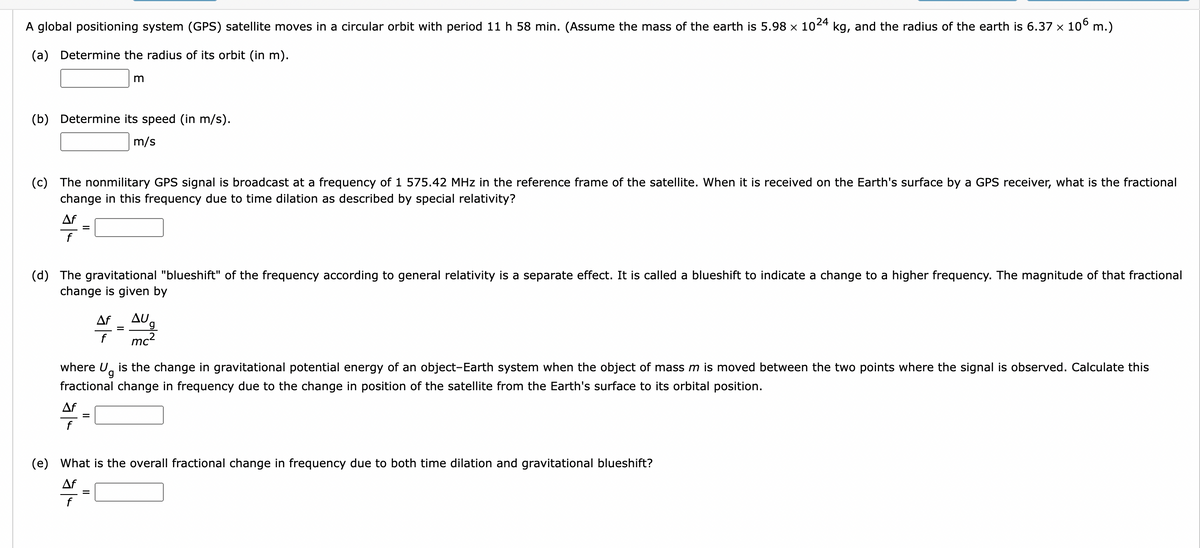A global positioning system (GPS) satellite moves in a circular orbit with period 11 h 58 min. (Assume the mass of the earth is 5.98 x 1024 kg, and the radius of the earth is 6.37 x 106 m.) (a) Determine the radius of its orbit (in m). m (b) Determine its speed (in m/s). m/s (c) The nonmilitary GPS signal is broadcast at a frequency of 1 575.42 MHz in the reference frame of the satellite. When it is received on the Earth's surface by a GPS receiver, what is the fractional change in this frequency due to time dilation as described by special relativity? = (d) The gravitational "blueshift" of the frequency according to general relativity is a separate effect. It is called a blueshift to indicate a change to a higher frequency. The magnitude of that fractional change is given by Af AU f mc² = where U, is the change in gravitational potential energy of an object-Earth system when the object of mass m is moved between the two points where the signal is observed. Calculate this fractional change in frequency due to the change in position of the satellite from the Earth's surface to its orbital position.
A global positioning system (GPS) satellite moves in a circular orbit with period 11 h 58 min. (Assume the mass of the earth is 5.98 x 1024 kg, and the radius of the earth is 6.37 x 106 m.) (a) Determine the radius of its orbit (in m). m (b) Determine its speed (in m/s). m/s (c) The nonmilitary GPS signal is broadcast at a frequency of 1 575.42 MHz in the reference frame of the satellite. When it is received on the Earth's surface by a GPS receiver, what is the fractional change in this frequency due to time dilation as described by special relativity? = (d) The gravitational "blueshift" of the frequency according to general relativity is a separate effect. It is called a blueshift to indicate a change to a higher frequency. The magnitude of that fractional change is given by Af AU f mc² = where U, is the change in gravitational potential energy of an object-Earth system when the object of mass m is moved between the two points where the signal is observed. Calculate this fractional change in frequency due to the change in position of the satellite from the Earth's surface to its orbital position.
University Physics Volume 1
18th Edition
ISBN:9781938168277
Author:William Moebs, Samuel J. Ling, Jeff Sanny
Publisher:William Moebs, Samuel J. Ling, Jeff Sanny
Chapter13: Gravitation
Section: Chapter Questions
Problem 49P: The “mean” orbital radius listed for astronomical objects orbiting the Sun is typically not an...
Related questions
Question
100%

Transcribed Image Text:A global positioning system (GPS) satellite moves in a circular orbit with period 11 h 58 min. (Assume the mass of the earth is 5.98 x 1024 kg, and the radius of the earth is 6.37 x 106 m.)
(a) Determine the radius of its orbit (in m).
(b) Determine its speed (in m/s).
m/s
(c) The nonmilitary GPS signal is broadcast at a frequency of 1 575.42 MHz in the reference frame of the satellite. When it is received on the Earth's surface by a GPS receiver, what is the fractional
change in this frequency due to time dilation as described by special relativity?
f
m
(d) The gravitational "blueshift" of the frequency according to general relativity is a separate effect. It is called a blueshift to indicate a change to a higher frequency. The magnitude of that fractional
change is given by
Af
f
=
ΔU.
g
mc²
where U is the change in gravitational potential energy of an object-Earth system when the object of mass m is moved between the two points where the signal is observed. Calculate this
fractional change in frequency due to the change in position of the satellite from the Earth's surface to its orbital position.
Af
(e) What is the overall fractional change in frequency due to both time dilation and gravitational blueshift?
Af
Expert Solution
This question has been solved!
Explore an expertly crafted, step-by-step solution for a thorough understanding of key concepts.
Step by step
Solved in 4 steps with 4 images

Follow-up Questions
Read through expert solutions to related follow-up questions below.
Knowledge Booster
Learn more about
Need a deep-dive on the concept behind this application? Look no further. Learn more about this topic, physics and related others by exploring similar questions and additional content below.Recommended textbooks for you

University Physics Volume 1
Physics
ISBN:
9781938168277
Author:
William Moebs, Samuel J. Ling, Jeff Sanny
Publisher:
OpenStax - Rice University

An Introduction to Physical Science
Physics
ISBN:
9781305079137
Author:
James Shipman, Jerry D. Wilson, Charles A. Higgins, Omar Torres
Publisher:
Cengage Learning

Physics for Scientists and Engineers: Foundations…
Physics
ISBN:
9781133939146
Author:
Katz, Debora M.
Publisher:
Cengage Learning

University Physics Volume 1
Physics
ISBN:
9781938168277
Author:
William Moebs, Samuel J. Ling, Jeff Sanny
Publisher:
OpenStax - Rice University

An Introduction to Physical Science
Physics
ISBN:
9781305079137
Author:
James Shipman, Jerry D. Wilson, Charles A. Higgins, Omar Torres
Publisher:
Cengage Learning

Physics for Scientists and Engineers: Foundations…
Physics
ISBN:
9781133939146
Author:
Katz, Debora M.
Publisher:
Cengage Learning

Principles of Physics: A Calculus-Based Text
Physics
ISBN:
9781133104261
Author:
Raymond A. Serway, John W. Jewett
Publisher:
Cengage Learning